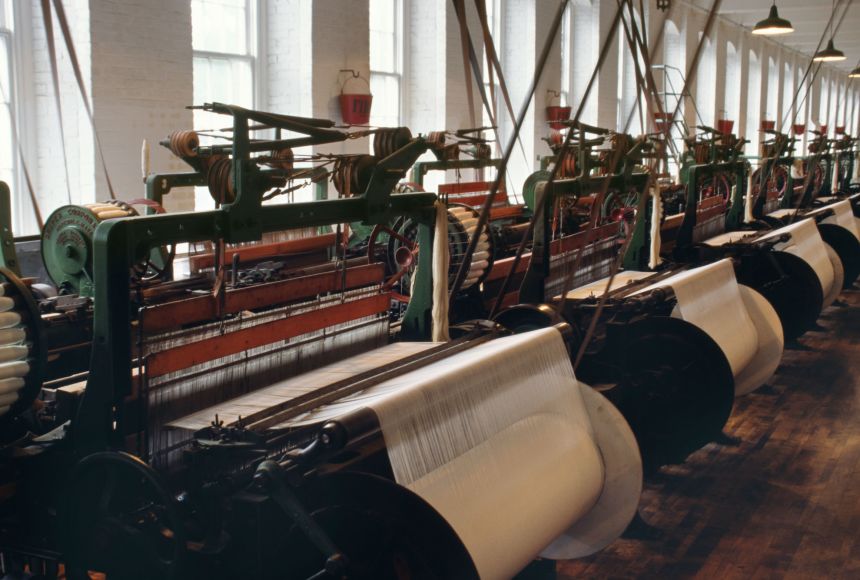The Industrial Revolution changed the world by transforming business, economics, and society. These shifts had major effects on the world and continue to shape it today.
Before industrialization, most European countries had economies dominated by farming and artisan crafts such as hand-woven cloth. Social structures had remained largely unchanged since the Middle Ages. Yet once industrialization commenced, work and family life transformed.
According to most historians, the Industrial Revolution began in Great Britain in the middle of the 18th century. At the time, most people rarely traveled beyond the small and medium-sized villages where they lived. Rural people worked as subsistence farmers, which meant they grew crops to feed themselves and their families, not to trade or sell.
The European population grew substantially during the 18th century, and farmers increased production to keep pace. Machines became widely used in farming, and consequently, farms required fewer workers. Large, technologically advanced farms replaced subsistence farms.
Industrial Revolution's Lasting Effect on Farming
The Industrial Revolution demonstrates an idea known as economies of scale. According to this principle, increased production of goods leads to increased efficiency. For peasants, however, large-scale production meant fewer economic opportunities. Conditions worsened due to the enclosure movement. Previously, villages had shared lands for grazing animals that could be used by all villagers. Once large-scale agriculture became widespread, wealthy people bought these lands and used them for private farms.
More and more people in rural communities struggled. Many left their old lives behind and headed for towns and cities to find new employment. The growth of British cities was further accelerated by the development of factories. Industrial cities such as Manchester and Leeds grew dramatically in just a few decades.
In 1800, about 20 percent of the British population lived in cities. In just 50 years, by the middle of the 19th century, that number had risen to 50 percent. Other Western European nations, including France, the Netherlands, and Germany, also saw an increase in the urban population, although their changes proceeded at a slower rate.
Factory work in urban areas differed from farming. Before the Industrial Revolutions, artisans such as jewelers, weavers, and blacksmiths produced most manufactured goods. The mains sources of energy were human and animal muscle, along with the waterwheel.
Families Were Forced To Focus on Factory Work
The dawn of industrialization came alongside inventions such as the coal-powered steam engine, and the pace of work increased as a result. In factories, coal mines and other industrial workplaces, workers put in long hours in miserable and dangerous conditions. As countries industrialized, factories became larger and produced more goods. Larger companies that were able to achieve economies of scale did better in international trade. Earlier forms of work began to disappear.
Perhaps the most harmful consequences of industrialization were those affecting families. Before industrialization, families served both social and economic purposes. Married couples and their children often worked together in farms or shops. In 18th-century Great Britain, women and men often worked in their homes doing jobs such as spinning wool into textiles and weaving textiles into cloth. They then sold their products in a system that was called the "putting-out" or domestic system.
However, the rise of factories meant that most male workers no longer worked at home. Some men left their families behind for jobs in the city. Even when men stayed with their families, factory jobs were oftentimes so difficult that they had little time for relaxation and family life after returning from work.
Child Labor and Other Economic Changes
Women also worked outside the home. Unmarried women commonly worked as servants in other families' homes. Many British women, including mothers, worked in textile mills. During the first century of industrialization, child labor was common. Factory owners appreciated workers whose fingers were small enough to weave thin threads in complex machines. Despite their important contributions, women and children received low pay for their labor. They were commonly forced to work 16 hours per day or longer. Although their work conditions could be quite dangerous, women's jobs were perceived as less skilled than those of their male co-workers.
Industrialization caused similar social changes in the United States. There, manufacturing began after the nation gained independence from England in the 1770s. President Thomas Jefferson, whose administration spanned from 1801 to 1809, later established a trade embargo. Jefferson's embargo banned foreign countries from sending their goods to the United States. This would mean those countries would not get the money from trading with the United States. It also increased the demand for U.S.-made supplies.
During the War of 1812, the British navy prevented ships from going in and out of U.S. ports, which further drove the development of U.S. industries. By the 1830s, the United States had become one of the world's leading economic powers.
The Booming Working Class
In the first 50 years after U.S. independence, many agricultural workers moved to take on manufacturing jobs. As in Great Britain, textile production led the way. Industrialization, along with advancements in transportation like the railroad, drove economic growth and urbanization in the United States. A large working class developed, eventually leading to conflict between workers and factory owners. Working men and women led labor strikes to demand safer working conditions and higher pay.
By the late 19th and early 20th centuries, industrialized nations like Great Britain and the United States began passing laws to improve conditions for factory workers. However, harsh conditions then arose in other parts of the world alongside factories. We continue to live with the effects of industrialization today.

